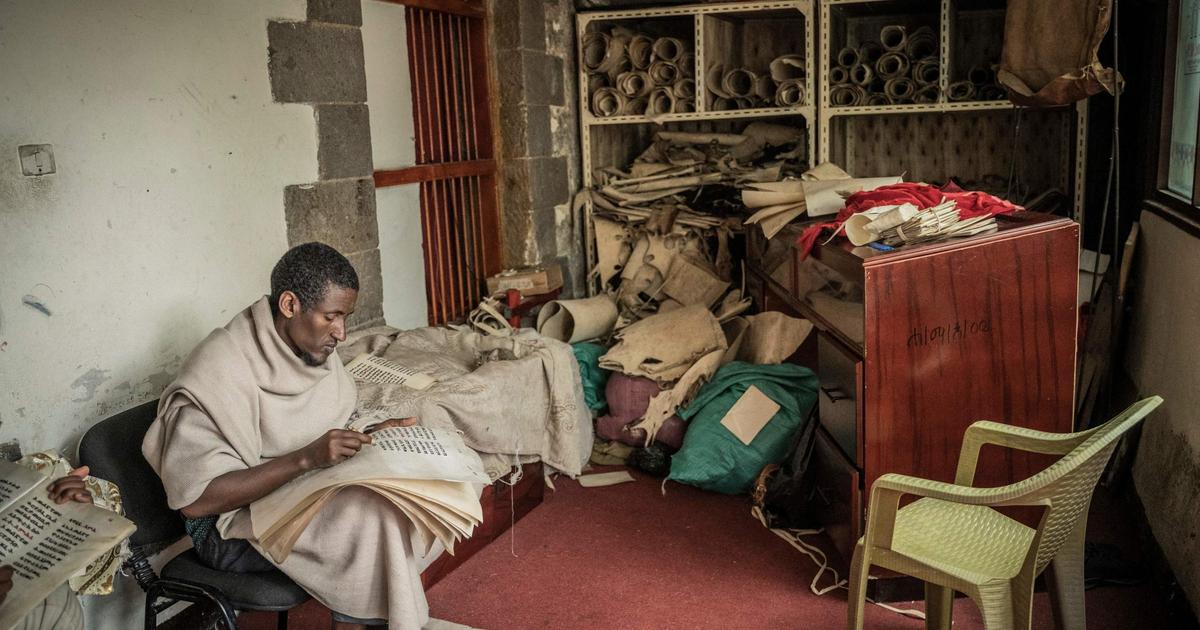With a sure gesture, with an inked bamboo stylus, Zelalem Mola copies a religious book on parchment. This long and tedious work, explains this Ethiopian Orthodox priest, preserves a tradition and ancient writings, while bringing him closer to God.
At the Hamere Berhan Institute in Addis Ababa, religious and lay believers strive to transcribe identically and by hand, on goat skins, liturgical works and ancient sacred paintings. Parchments, styluses and inks are prepared on site. "We started four years ago," says Yeshiemebet Sisay, 29, the association's communications officer: "What motivated us was that ancient parchment manuscripts disappear from our tradition." These works, some of which are centuries old, are kept mainly in monasteries, where liturgical songs and prayers are directed exclusively from these parchment manuscripts and "not from works on paper," she continues.
In the courtyard of the institute, in the Piasa district, the historic center of the Ethiopian capital, goat skins stretched on metal frames dry under a sun that hardly pierces a milky sky. "The goat skins were immersed in water for three to four days," says Tinsaye Chere Ayele, 20. "Then we removed the layer of fat inside and cleansed the skin," continues the young man who is busy, armed with a homemade scraper, in this thankless task with the other two young people, apparently little bothered by the sickening smell.
" READ ALSO Ethiopia: after the peace agreement, the inhabitants of Tigray try to rebuild
Once clean and dry, the skins are stripped of their hair and then cut to the desired size. The skins can be transformed into pages of a book or support of a painting. According to Yeshiemebet Sisay, most manuscripts, some of them of imposing size, were commissioned by private individuals who offered them to churches or monasteries.
Some customers order for themselves small prayer books or paintings, "reproductions of ancient Ethiopian works," she explains. Making "small books can take one or two months if the work is collective, large books can take one to two years. If it's an individual task, it can take even longer," she says, pointing to books with elaborate leather covers, texts adorned with brightly colored illuminations and accompanied by religious images.
Sitting in a room, the pages of parchment simply resting on his lap, without table or pulpit, priest Zelalem Mola patiently copies a book entitled Zena Selassie (History of the Trinity). It's "going to take a long time. It is hard work, starting with the preparation of parchment and inks. This one could take up to six months to complete," he said. "We make a stylus from bamboo, sharpening the tip with a razor blade," he says. A different stylus is used for each color, red or black. Fine-tipped pens and wide-tipped pens according to the desired thickness of the characters andwe make the inks from different plants."
" READ ALSO "What do we have to learn from relations between Catholics and Orthodox?"
"Spirit of God"
Like most other religious works, Zena Selassie is written in Ge'ez. This dead language has remained the liturgical language of the Orthodox Church in Ethiopia and its alpha syllabic writing system where characters represent syllables remains used to write Amharic, Ethiopia's national language, and Tigrinya, spoken in Tigray (northern Ethiopia) and Eritrea.
"We copy paper to the parchment to preserve" the writings, because "the paper book can be easily damaged, while it will last a long time if we protect it from water and fire," the priest continues. The characters are also larger, "which can help monks in monasteries." "This work requires patience and concentration," he says. It's hard for someone to calligraphy a book to the end, just to sit all day. But thanks to our devotion, a light shines in us and it takes so much effort that it values us in God's eyes."
This spiritual dimension also guides Lidetu Tasew, 26, responsible for education and training at the institute, where he teaches painting and illuminations, which are practiced diligently by concentrated students. For him, raised in a church and steeped in tradition, "spending time here painting saints is like talking to saints and God." "We have been taught that where saints are painted, the spirit of God is present."














